Ohio is a state that is home to a wide variety of birds. From migratory waterfowl to permanent residents, the state of Ohio provides a habitat for over 400 species of birds.
From the snowy owl to the bald eagle, Ohio offers a unique opportunity to observe various species in their natural habitats.
This introduction will explore some of Ohio’s most common and interesting birds, as well as their behaviour, habitats, and conservation status.
49 Birds Of Ohio
Ohio is home to diverse bird species due to its varied landscapes, from wetlands and forests to urban areas. While there are more than 400 bird species recorded in Ohio, here are 49 notable birds commonly found in the state:
1. Cardinal
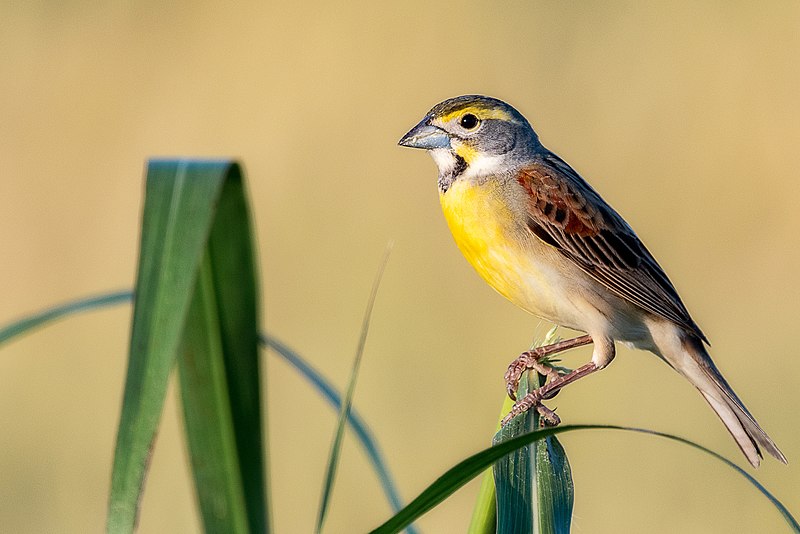
Cardinalidae is a family of passerine birds endemic to the New World, including cardinals, grosbeaks and buntings.
This large group has great diversity in its members, ranging from tanager-like Piranga to warbler-like Granatellus.
They are usually distinguished by their bright plumage, with reds, oranges and yellows being common among them.
Their strong bills enable them to feed on seeds, fruits, insects, and other small prey items like lizards or frogs, depending upon species.
Cardinals also have loud calls often used for territorial defence and courtship purposes, while some can even imitate sounds made by other animals.
These adaptable birds inhabit various habitats across North America, making them an important part of many ecosystems there.
Scientific classification:
| Kingdom | Animalia |
| Phylum | Chordata |
| Class | Aves |
| Order | Passeriformes |
| Superfamily | Emberizoidea |
| Family | Cardinalidae Ridgway, 1901 |
2. Northern Cardinal
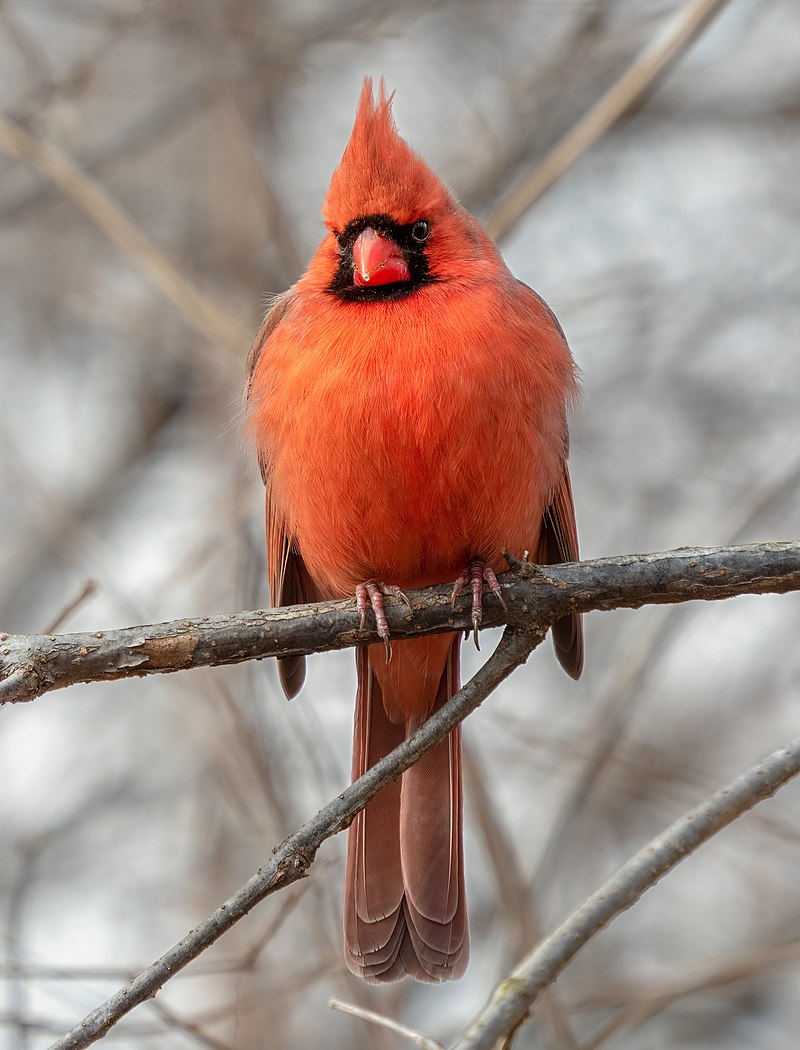
The Northern Cardinal is a beautiful bird, easily identified by its bright red plumage. It can be found in the eastern United States from Maine to Minnesota and south through Mexico and Belize.
Along with its striking colouration, it has a distinctive crest on its head and sharp black facial markings around the eyes.
Despite their small size (measuring 7-9 inches) they are very vocal birds – males sing persistently throughout springtime to attract mates or proclaim their territory.
They typically feed on insects, seeds and fruits but also enjoy suet at backyard bird feeders.
The female is less brightly coloured than her mate but still stands out among other songbirds due to her warm brownish-red feathers.
Cardinals pair for life, so you may often see them together in your garden or neighbourhood park.
Scientific classification:
| Kingdom | Animalia |
| Phylum | Chordata |
| Class | Aves |
| Order | Passeriformes |
| Family | Cardinalidae |
| Genus | Cardinalis |
| Species | C. cardinalis |
3. House Sparrow
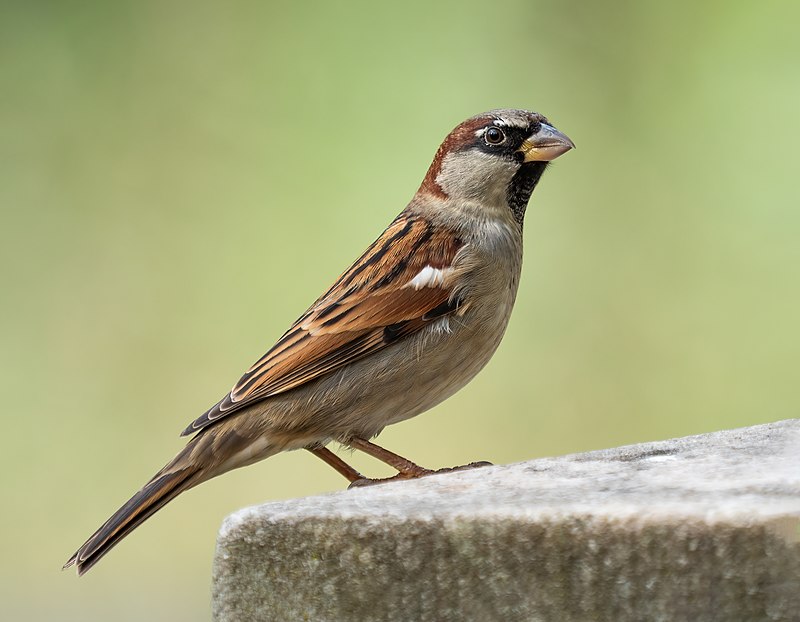
The house sparrow is a small bird of the Passeridae family. It has an average length of 16 cm and weighs 24-39.5 gm.
Females have dull brown and grey plumage, whereas males are brighter, with black, white and brown markings on their wings and back feathers.
This species is one among 25 different kinds in its genus Passer. These birds are found worldwide, mainly near human dwellings where they feed off food scraps from garbage bins or gardens, etc.
They also make nests close to houses, making them even more visible to nearby people.
House sparrows can be seen hopping around yards for food during daytime hours but usually hide in colonies at night.
Scientific classification:
| Kingdom | Animalia |
| Phylum | Chordata |
| Class | Aves |
| Order | Passeriformes |
| Family | Passeridae |
| Genus | Passer |
| Species | P. domesticus |
4. Blue Jay
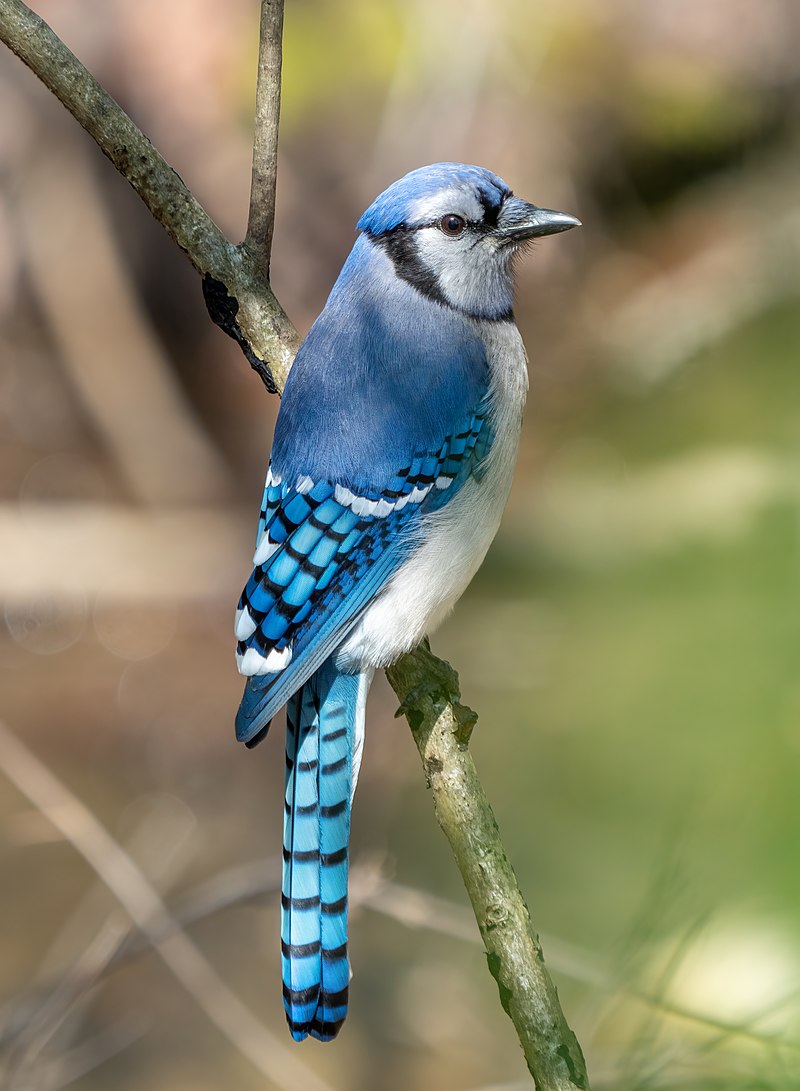
The Blue Jay is a beautiful bird residing in the eastern and central United States and Newfoundland, Canada.
They have an unmistakable blue-coloured plumage with white markings on their heads and wings.
These birds are highly adaptable to different habitats ranging from deciduous forests to urban areas.
As part of the Corvidae family, they are known for being intelligent problem solvers who will often use tools or mimic vocalizations of other species, like hawks, when defending their territories.
Their diet consists mostly of insects, seeds and nuts but can also include small vertebrates such as frogs or lizards if food resources become scarce.
Overall these birds provide much needed color to our environment while playing important roles in maintaining healthy ecosystems through pollination services and seed dispersal activities.
Scientific classification:
| Kingdom | Animalia |
| Phylum | Chordata |
| Class | Aves |
| Order | Passeriformes |
| Family | Corvidae |
| Genus | Cyanocitta |
| Species | C. cristata |
5. American Robin

The American robin is a migratory bird belonging to the true thrush genus and Turdidae family.
It was named after its European counterpart due to the similar reddish-orange breast they possess; however, they are not closely related.
This species can be seen through most of North America during winter months and in parts of Mexico and Central America, where it also breeds.
They have plump bodies with grey upperparts and white underparts that vary from yellow on their throats down to orange toward their bellies.
Robins feed on fruits such as berries or insects like worms, making them an important part of ecosystems by helping disperse seeds naturally throughout these areas.
Scientific classification:
| Kingdom | Animalia |
| Phylum | Chordata |
| Class | Aves |
| Order | Passeriformes |
| Family | Turdidae |
| Genus | Turdus |
| Species | T. migratorius |
6. American Goldfinch
The American goldfinch is a small North American bird in the finch family. Males are vibrant yellow with black wings and tails, while females are duller in colouration.
It migrates from mid-Alberta to North Carolina during the breeding season, south of Canada–United States border to Mexico for its wintering grounds.
The only finch that undergoes complete moult every year displays sexual dichromatism, where males have brighter colours than their female counterparts.
They feed mainly on seeds but also eat insects such as aphids and caterpillars when raising young; they often occur near thistles or other plants that produce viable seed heads. Their call consists of various chirps and trills, making them quite conspicuous.
Scientific classification:
| Kingdom | Animalia |
| Phylum | Chordata |
| Class | Aves |
| Order | Passeriformes |
| Family | Fringillidae |
| Subfamily | Carduelinae |
| Genus | Spinus |
| Species | S. tristis |
7. Mourning Dove
The Mourning Dove is a breathtakingly beautiful bird. It has stunning grey and brown feathers with white-tipped wings, giving it an elegant appearance. Its long tail also adds to its graceful look in flight.
A symbol of peace and serenity, they are abundant across North America and can be found in gardens or open fields throughout the year.
As well as being popular game birds for hunters, they feed on grains such as wheat and millet, providing important food sources for wildlife species, including foxes, coyotes, skunks and raccoons.
These doves have a distinctive cooing sound that can often echo through woodlands during summer evenings, making them one of nature’s greatest treasures.
Scientific classification:
| Kingdom | Animalia |
| Phylum | Chordata |
| Class | Aves |
| Order | Columbiformes |
| Family | Columbidae |
| Genus | Zenaida |
| Species | Z. macroura |
8. Red-Winged Blackbird

The red-winged blackbird is a beautiful bird found in most of North America and Central America.
Its distinct features include a glossy black body, with white shoulder patches and bright red wing coverts year round.
It prefers wetland habitats such as marshes, ponds, lakeshores and agricultural fields. During breeding season, they inhabit grassy areas near water, then move south for the winter months.
For food, they mainly eat insects but also consume wild fruit or grains.
They are very social birds, often seen in large flocks during migration times when their unmistakable “conk-la-ree” call can be heard echoing across the sky.
Scientific classification:
| Kingdom | Animalia |
| Phylum | Chordata |
| Class | Aves |
| Order | Passeriformes |
| Family | Icteridae |
| Genus | Agelaius |
| Species | A. phoeniceus |
9. House Finch

The House Finch is a finch species native to western North America and has been introduced in the eastern half of the continent and Hawaii.
It’s an average-sized finch with adults measuring 12.5 – 15 cm (5 – 6 inches) long and wingspan between 20 – 25 cm (8 – 10 inches).
The upper parts are brown, while its underparts range from pale greyish white to yellow, depending on subspecies.
Its face is streaked or spotted with reddish coloration; males typically have brighter plumage than females due to sexual dimorphism.
They’re mostly found near human habitations such as farms and gardens, where they feed on grains, fruits, insects, etc., making them very popular among birders who want something colourful for their backyard.
Scientific classification:
| Kingdom | Animalia |
| Phylum | Chordata |
| Class | Aves |
| Order | Passeriformes |
| Family | Fringillidae |
| Subfamily | Carduelinae |
| Genus | Haemorhous |
| Species | H. mexicanus |
10. Downy Woodpecker
The downy woodpecker is a small species of woodpecker found in North America. Growing up to 7 inches long, it can be identified by its white belly and spotted wings.
It inhabits forests throughout the United States and Canada, with the exception of deserts in the southwest and northern tundra.
This bird nests in tree cavities and feeds mostly on insects but will supplement its diet with fruit or nuts when available.
The Downy Woodpecker has an unmistakable call that sounds like a loud ‘piker’, similar to other members of its family, such as the Hairy Woodpecker.
Scientific classification:
| Kingdom | Animalia |
| Phylum | Chordata |
| Class | Aves |
| Order | Piciformes |
| Family | Picidae |
| Genus | Dryobates |
| Species | D. pubescens |
11. White-Breasted Nuthatch
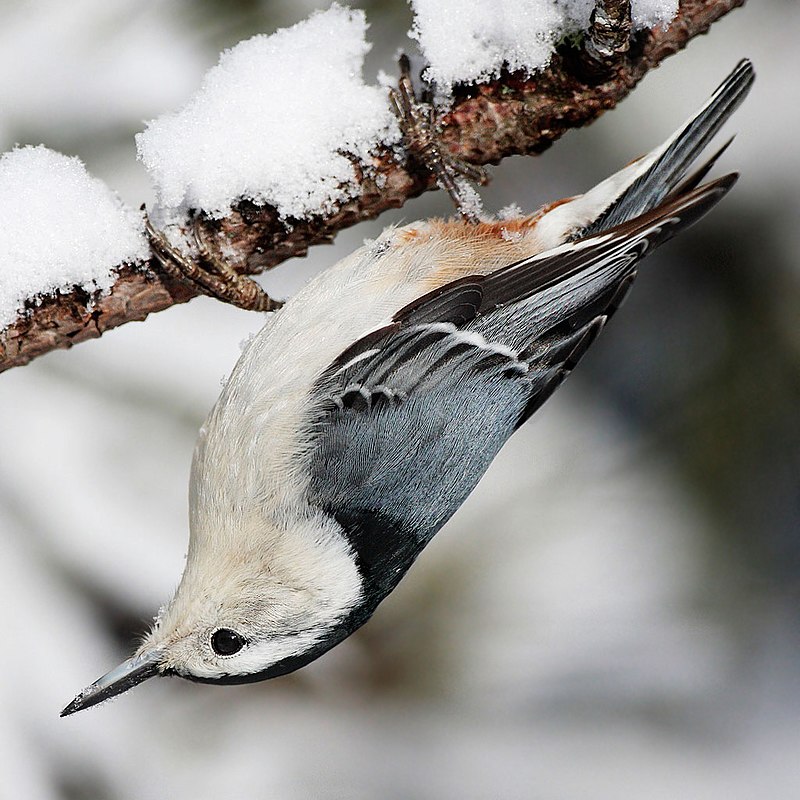
The White-breasted Nuthatch is a medium-sized bird belonging to the nuthatch family Sittidae. It measures around 15.5 cm long, and its colour varies throughout its range.
Males have a light blue-grey upperpart, with a black crown and nape, whereas females have a dark grey crown instead of a black one.
The underparts are whitish, with reddish tinge on sides and flanks while the bill is short and stout with pale base near eyes which can be yellow or white depending upon geographic location..
This species feeds mainly on insects but will also eat seeds, nuts and berries when available.
They prefer open woodlands where they often climb trees searching for food along trunks and branches underneath bark crevices, creating their nest there too.
Scientific classification:
| Kingdom | Animalia |
| Phylum | Chordata |
| Class | Aves |
| Order | Passeriformes |
| Family | Sittidae |
| Genus | Sitta |
| Species | S. carolinensis |
12. Red-Bellied Woodpecker
The Red-bellied woodpecker is a beautiful bird with an orange-red crown and nape. It breeds mainly in the eastern United States, ranging from Florida to Canada.
This medium-sized woodpecker of the family Picidae has black wings, white stripes on its back and tail feathers that are barred with black.
Its underside is mostly pale yellow or white but has some red colouration around its neck.
Despite this subtle red hue, it should not be mistaken for the entirely red head and neck belonging to the Red-headed woodpecker of the same genus, Melanerpes carolinus.
The Red-bellied Woodpeckers’ diet consists primarily of insects such as ants, beetles and grasshoppers, along with nuts, fruits, berries and tree sap, which they will feed upon at different times throughout their life cycle.
Scientific classification:
| Kingdom | Animalia |
| Phylum | Chordata |
| Class | Aves |
| Order | Piciformes |
| Family | Picidae |
| Genus | Melanerpes |
| Species | M. carolinus |
13. Common Starling

The Common Starling is a medium-sized passerine bird that belongs to the starling family. It has glossy black plumage with a metallic sheen; at certain times of the year, it can be speckled with white.
The bill and legs are typically pink or black depending on the season, while its length measures about 8 inches long. Its diet consists mainly of insects but includes small fruits, seeds, and human food waste.
They live in large flocks, which provides protection against predators, although they can become quite aggressive when defending their nesting sites during breeding seasons.
Overall, this species is highly adaptable and widely distributed across many parts of Europe, making them one of the most successful birds in the region today.
Scientific classification:
| Kingdom | Animalia |
| Phylum | Chordata |
| Class | Aves |
| Order | Passeriformes |
| Family | Sturnidae |
| Genus | Sturnus |
| Species | S. vulgaris |
14. Finches
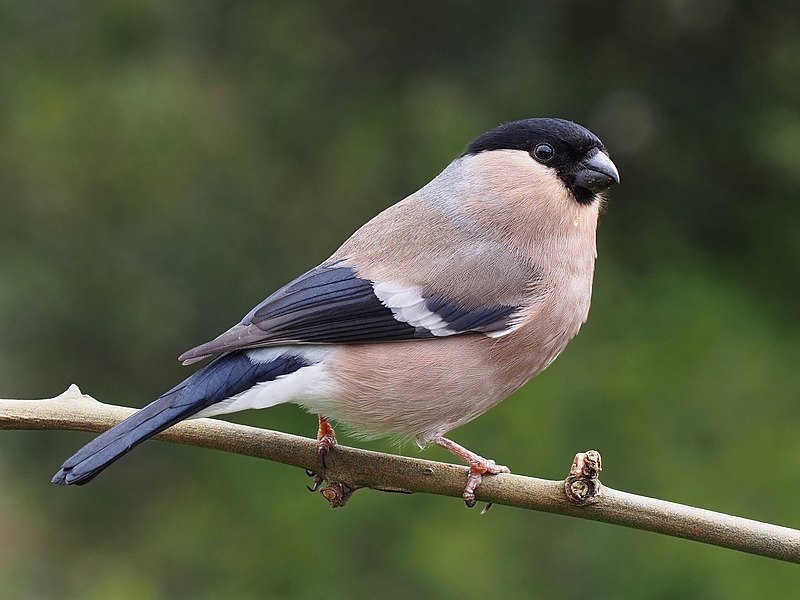
Finches are a diverse group of passerine birds found worldwide, excluding Australia and polar regions. They vary in size from small to medium-sized, with stout conical bills adapted for eating seeds and nuts.
Many species have brightly coloured plumage; this helps them stand out against their natural habitats, ranging from deserts to forests.
Finches occupy these areas all year round without migrating elsewhere – making them particularly well suited for local environments.
As part of the Fringillidae family, they possess unique characteristics that make them popular amongst birdwatchers everywhere.
Scientific classification:
| Kingdom | Animalia |
| Phylum | Chordata |
| Class | Aves |
| Order | Passeriformes |
| Superfamily | Passeroidea |
| Family | Fringillidae Leach, 1820 |
15. Carolina Chickadee
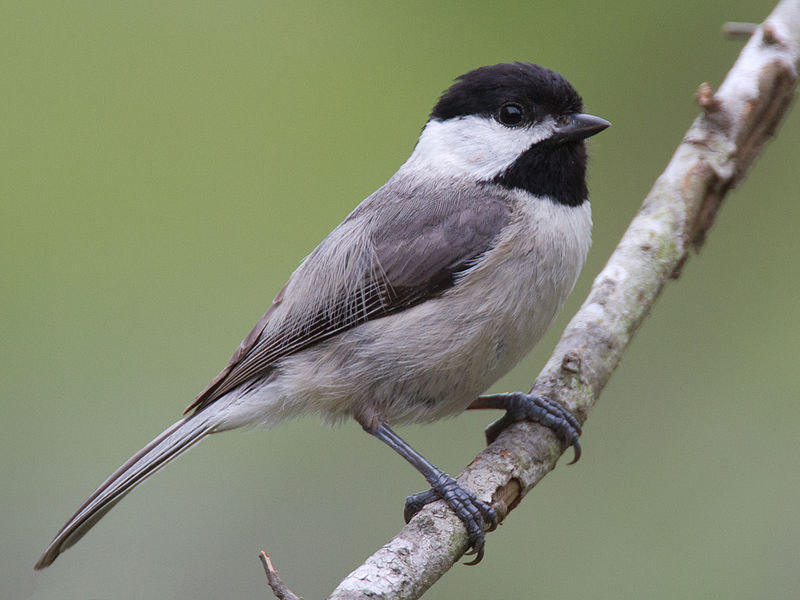
The Carolina Chickadee is a small passerine bird found in the tit family Paridae. It stands out for its distinct black and white, grey-brown feathers with an off-white underside.
This species can be spotted by its call: “chick-a-dee”. The American Ornithologists’ Union has classified them into their own genus called Poecile, as they differ from other tits due to both genetic data and morphology.
These birds live in wooded areas near open fields or water sources all over North America.
They feed on insects such as caterpillars but have also been known to eat suet at backyard feeders during winter when food is scarce.
Scientific classification:
| Kingdom | Animalia |
| Phylum | Chordata |
| Class | Aves |
| Order | Passeriformes |
| Family | Paridae |
| Genus | Poecile |
| Species | P. carolinensis |
16. Black-Capped Chickadee
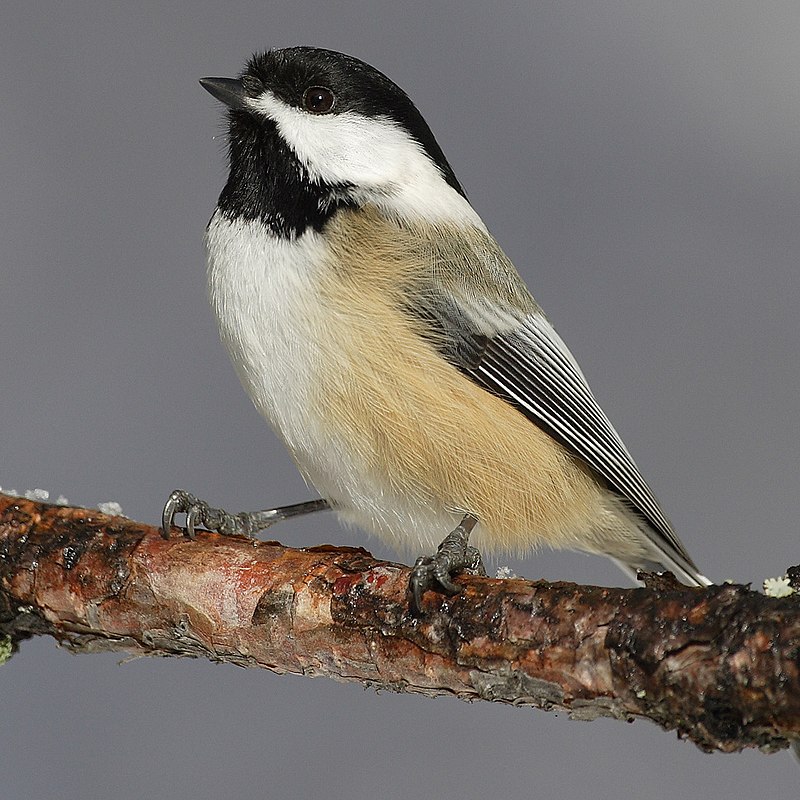
The black-capped chickadee is a small, cheerful songbird in deciduous and mixed forests across North America. It has an iconic black cap, white cheeks, gray back and wings with whitish bars on them.
The underparts are usually light-coloured or greyish-brown. This species is well adapted to cold winters as it can reduce its body temperature by up to 8°C while roosting at night; this helps save energy during the year’s colder months.
It feeds mainly on insects but also eats seeds, fruits and suet from bird feeders when available.
Black-capped chickadees are popular birds among backyard visitors due to their sociable nature – they often establish lifelong partnerships with one another for breeding purposes.
Furthermore, they have been designated as state birds of Massachusetts and Maine in USA plus New Brunswick in Canada – a testament to how beloved these little avian friends truly are.
Scientific classification:
| Kingdom | Animalia |
| Phylum | Chordata |
| Class | Aves |
| Order | Passeriformes |
| Family | Paridae |
| Genus | Poecile |
| Species | P. atricapillus |
17. Song Sparrow
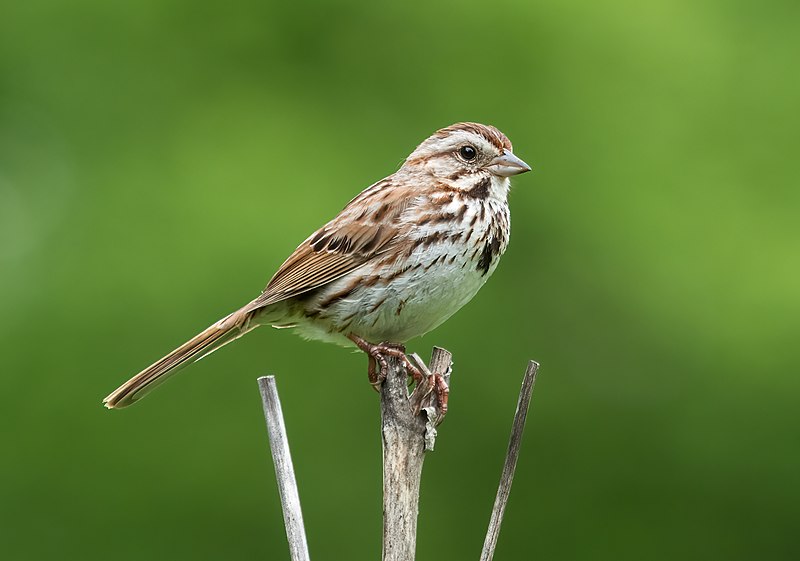
The Song Sparrow (Melospiza melodia) is a small, yet abundant bird found in North America.
They have brown upperparts with dark streaks and are white underneath, complete with a distinct dark brown spot on the breast.
Their cap is also brown, and long, rough feathers can be seen sprouting from their neck area.
This sparrow species is highly variable and adaptable to many different environments, including dry brush land, wetlands or open fields.
It has been noted that adult song sparrows will sing even during winter months when other birds remain quiet.
These energetic little animals make great backyard companions as they sing their lovely melodies.
Scientific classification:
| Kingdom | Animalia |
| Phylum | Chordata |
| Class | Aves |
| Order | Passeriformes |
| Family | Passerellidae |
| Genus | Melospiza |
| Species | M. melodia |
18. Dark-Eyed Junco

The Dark-eyed Junco is a species of small, greyish sparrows that are found across much of temperate North America and in the Arctic during summer.
Carl Linnaeus formally described it in 1766 and named it after its distinctive dark eyes.
This bird has a very variable appearance due to the many different subspecies it contains, making its systematics difficult to unravel.
The plumage varies from white or light grey on their underparts with slate grey backs and wings, black heads with white outer tail feathers, brown head stripes, yellow bills, pink legs and feet, and various shades between all these colours.
They also have considerable sexual dimorphism; males tend to be more colourful than females but share similar characteristics such as short tails and rounded bodies – both sexes being around 16 cm long when fully grown.
Scientific classification:
| Kingdom | Animalia |
| Phylum | Chordata |
| Class | Aves |
| Order | Passeriformes |
| Family | Passerellidae |
| Genus | Junco |
| Species | J. hyemalis |
19. Wrens
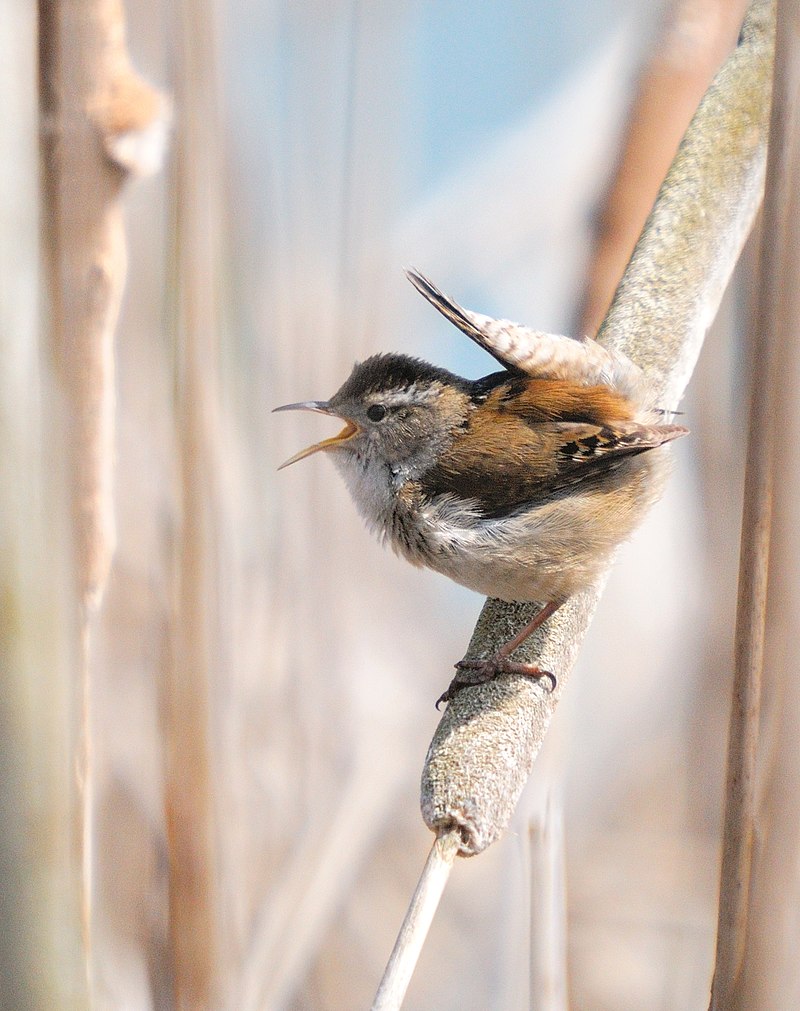
Wrens are a family of small brown passerine birds found mainly in the Americas. They are considered one of the most abundant bird species, with 88 known varieties divided into 19 genera.
The Eurasian wren is the only type inhabiting Europe and other parts of the Old World, commonly referred to simply as “wren.”
This species has been given its name due to similar-looking unrelated birds living elsewhere, such as New Zealand wrasses.
Wrens have tiny bodies with thin bills and long tails, which they often hold upright for hours at a time while singing their loud, cheery songs from treetops or low shrubs.
Their diet consists mostly of insects but can also include fruits and seeds depending on availability in their habitat range.
Scientific classification:
| Kingdom | Animalia |
| Phylum | Chordata |
| Class | Aves |
| Order | Passeriformes |
| Superfamily | Certhioidea |
| Family | Troglodytidae Swainson, 1832 |
20. Woodpeckers
Woodpeckers are an incredibly diverse bird species found worldwide except for Australia, New Guinea, New Zealand, Madagascar and the extreme polar regions.
They live in various habitats, including forests, woodlands, and rocky hillsides and deserts with no trees.
Their beaks are adapted to pecking at tree bark to find food, such as insects or larvae hidden beneath it, while they use their long tongues to catch them from deep inside crevices.
Woodpeckers have tough skulls that protect their brains from impact when they bang into things during drumming – a behaviour used by males for territorial signalling and reproduction purposes, which is done using strong, rapid beats against hollow objects like dead branches or metal poles.
Scientific classification:
| Kingdom | Animalia |
| Phylum | Chordata |
| Class | Aves |
| Order | Piciformes |
| Infraorder | Picides |
| Family | Picidae Leach, 1820 |
21. Tufted Titmouse
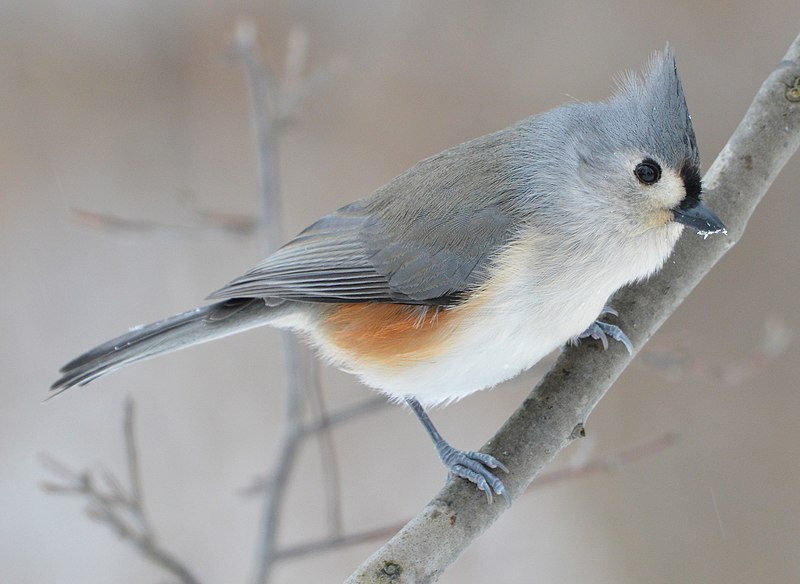
The Tufted Titmouse is a small, cheerful songbird found in North America. It’s part of the tit and chickadee family (Paridae).
It has distinctive white feathers around its eyes, grey-brown wings and upper body, with a pale tan underside.
Its most notable feature is the black crest on top of its head, which gives it an inquisitive look. The male also sports a pinkish breast, which can be seen.
When singing from high perches during the spring months. This bird loves to eat sunflower seeds or suet at backyard feeders and insects in summertime. You may even see them poking into crevices and bark, looking for food.
They are quite social birds, too, being often spotted in mixed flocks alongside other species, such as nuthatches and woodpeckers, all year round.
Scientific classification:
| Kingdom | Animalia |
| Phylum | Chordata |
| Class | Aves |
| Order | Passeriformes |
| Family | Paridae |
| Genus | Baeolophus |
| Species | B. bicolor |
22. Common Grackle
The Common Grackle is a large icterid bird commonly found in North America. It has an iridescent head and pale yellow eyes framed by its long dark bill and long tail.
Males typically have more vivid colours on their heads than females do. These birds can be seen across much of the continent, in fields, forests, wetlands – even urban areas.
They form huge flocks to search for food, such as grains or insects, that they catch with their bills.
If available, the grackles may also scavenge from human sources like garbage dumps or picnic tables. With its colorful plumage and distinct call it’s easy to spot this species amongst other birds.
Scientific classification:
| Kingdom | Animalia |
| Phylum | Chordata |
| Class | Aves |
| Order | Passeriformes |
| Family | Icteridae |
| Genus | Quiscalus |
| Species | Q. quiscula |
23. Eastern Bluebird
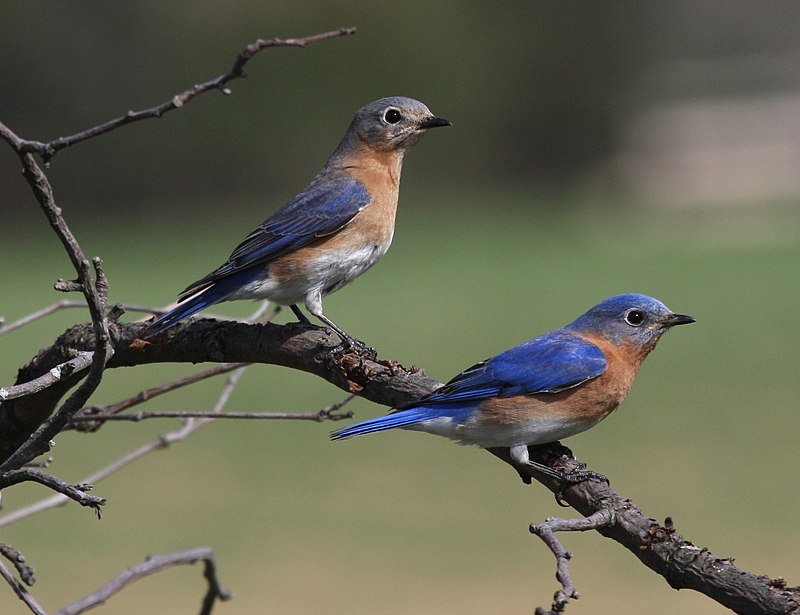
The Eastern bluebird is a small migratory thrush that can be found in open woodlands, farms and orchards across North America.
The male has bright-blue breeding plumage, which makes it easily recognizable by birders.
It produces melodious songs such as jeew, chir-wi and chiti WEEW wewidoo.
This popular species was declared the state bird of Missouri back in 1927 due to its beauty and charm.
In addition to being beautiful, these birds are also beneficial for farmers because they eat insects like grasshoppers and beetles, which damage crops.
They nest in cavities, so providing nesting boxes helps them thrive even more.
With their vibrant colours, sweet melodies and helpful nature, it’s easy to see why the Eastern Bluebird is beloved worldwide.
Scientific classification:
| Kingdom | Animalia |
| Phylum | Chordata |
| Class | Aves |
| Order | Passeriformes |
| Family | Turdidae |
| Genus | Sialia |
| Species | S. sialis |
24. Baltimore Oriole
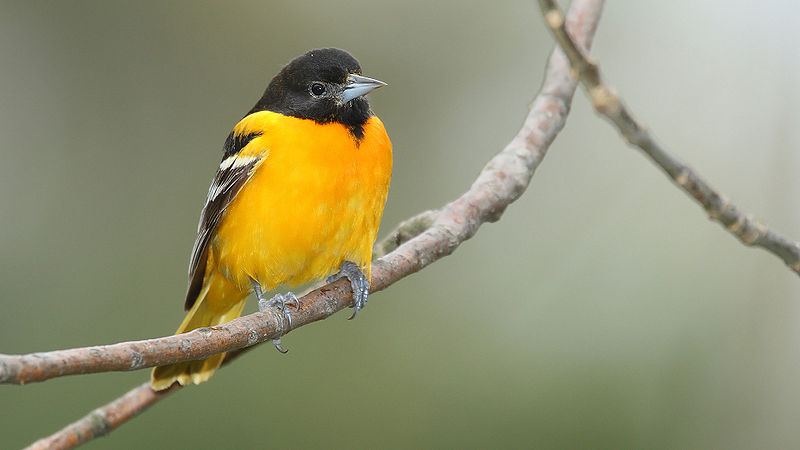
The Baltimore Oriole is a small, blackbird-like bird found in eastern North America. It’s named for the resemblance of its male colours to those on Lord Baltimore’s coat-of-arms from the 17th century.
These birds migrate and breed during springtime and are quite common in their habitats.
Studies have shown that this species interbreeds with western Bullock’s orioles, classifying both as a single species – Icterus galbula.
The males typically have orange feathers along the chest, back, wings and tail, while females display tan or yellowish shades instead of bright orange like males.
Both sexes share white wing bars and dark brown eyes, making them easily distinguishable from other birds.
They can often be seen flitting around trees, feeding off nectar buds or insects such as grasshoppers & caterpillars they catch while flying around.
Scientific classification:
| Kingdom | Animalia |
| Phylum | Chordata |
| Class | Aves |
| Order | Passeriformes |
| Family | Icteridae |
| Genus | Icterus |
| Species | I. galbula |
25. American Crow
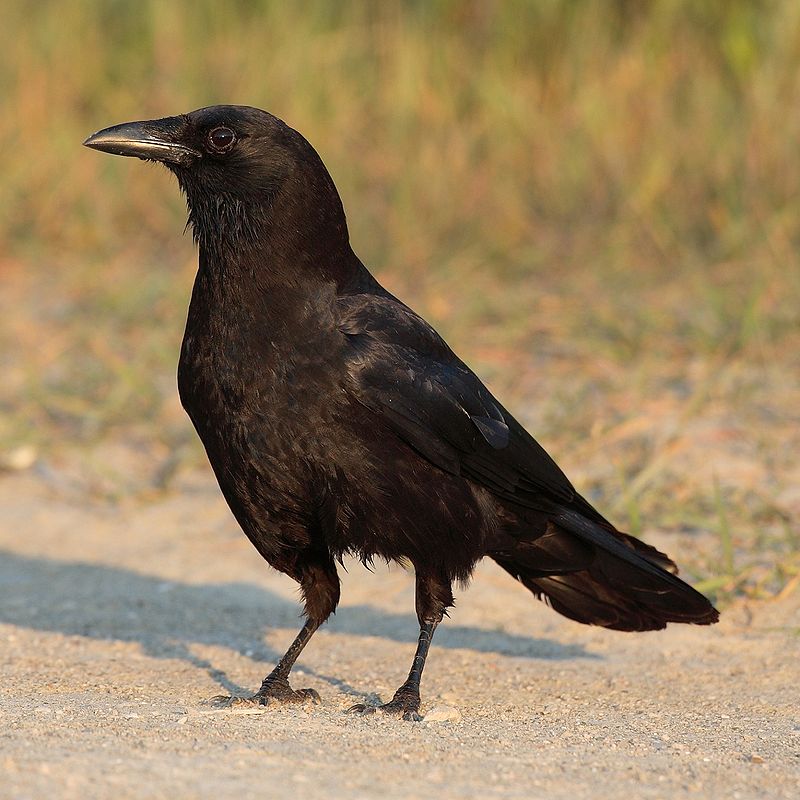
The American crow is a large bird of the Corvidae family, native to most parts of North America.
It is similar in size and structure to its European counterpart, the carrion crow, and Eurasia’s hooded crow.
The three species occupy the same ecological niche but are distinguishable by their differences in appearance.
American crows have black feathers covering their entire body, with wingspans averaging between 17-21 inches wide for males and 16-19 inches for females.
They feed on insects such as grasshoppers, beetles and caterpillars; they also eat grains from fields or abandoned farms during winter months when food sources become scarcer.
In addition to feeding habits American crows can be identified by their distinct call which resembles a “caw” sound that travels long distances over open terrain making them popular among birdwatchers.
Scientific classification:
| Kingdom | Animalia |
| Phylum | Chordata |
| Class | Aves |
| Order | Passeriformes |
| Family | Corvidae |
| Genus | Corvus |
| Species | C. brachyrhynchos |
26. Brown-Headed Cowbird
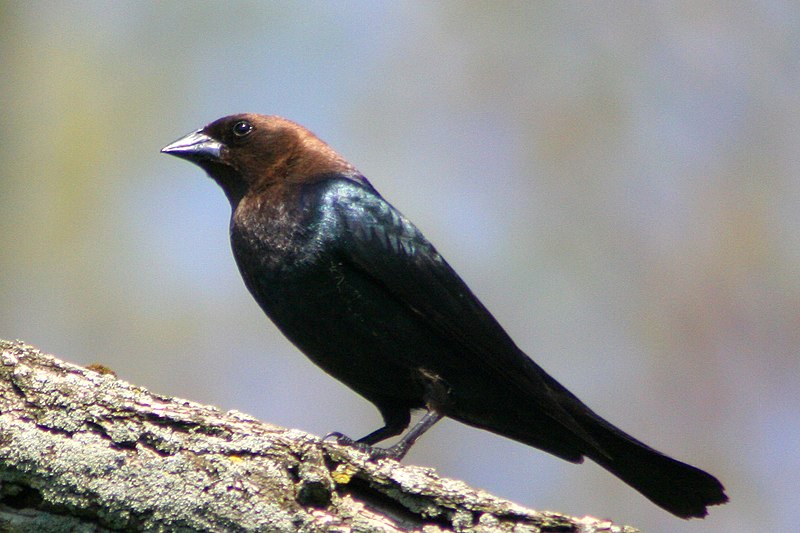
The Brown-headed Cowbird is a small, obligate brood parasitic icterid native to temperate and subtropical North America. It has a brown head with glossy black plumage on the body, wings and tail feathers.
During summer, they can be found in prairies, grasslands, and open wooded areas, but during winter, they migrate southwards towards the United States of Mexico for warmer climates.
They are mainly insectivorous birds that feed on insects like caterpillars or beetles but consume some grains.
The female bird lays its eggs in nests of other species then incubates them until hatching time, thus leaving their own chicks uncared for by themselves.
Scientific classification:
| Kingdom | Animalia |
| Phylum | Chordata |
| Class | Aves |
| Order | Passeriformes |
| Family | Icteridae |
| Genus | Molothrus |
| Species | M. ater |
27. Carolina Wren
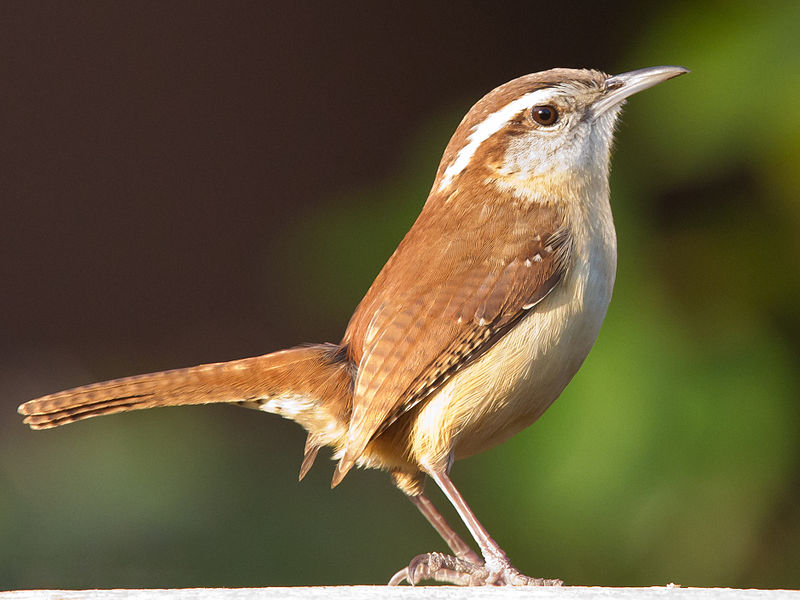
The Carolina wren (Thryothorus ludovicianus) is a medium-sized bird that can be found in the eastern United States, southern Ontario and northeast Mexico.
They typically live in dense shrubbery or thickets near open areas such as gardens, parks and woodland edges.
These birds are quite adaptable in nesting sites – they will build their nests anywhere from tree cavities to manmade boxes.
Their diet consists of insects, spiders and other invertebrates, which they forage for on the ground or among vegetation.
The males have an unmistakable song made up of loud whistles interspersed with trills reminiscent of laughter; you’ll often find these cheerful little birds singing away during early morning hours.
Scientific classification:
| Kingdom | Animalia |
| Phylum | Chordata |
| Class | Aves |
| Order | Passeriformes |
| Family | Troglodytidae |
| Genus | Thryothorus Vieillot, 1816[2] |
| Species | T. ludovicianus |
28. New World Warblers
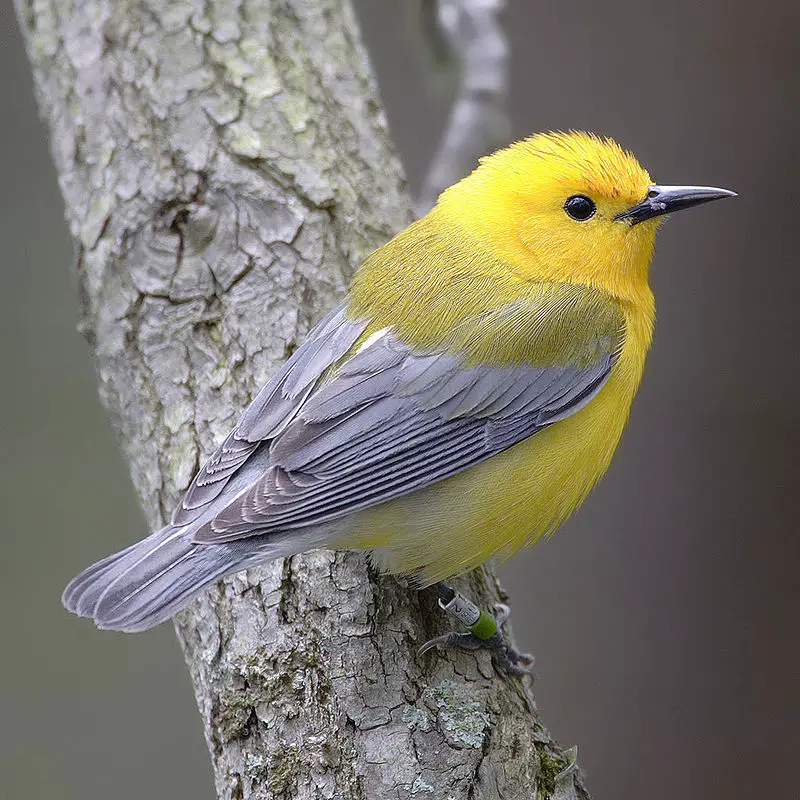
New World warblers are an incredibly diverse family of small birds found only in the Americas. They range in size from tiny hummingbirds to large thrushes and come in various vibrant colours.
All have thin bills made for eating insects, which form their main diet. Most species live predominantly arboreal lives, meaning they spend most of their time among trees or bushes searching for food.
However, some members, such as ovenbirds and waterthrushes, prefer more terrestrial habitats like forest floors where they can scavenge for bugs on the ground instead.
Warblers provide a great source of entertainment with their beautiful songs, often filling up woodlands during mornings and evenings throughout springtime.
Scientific classification:
| Kingdom | Animalia |
| Phylum | Chordata |
| Class | Aves |
| Order | Passeriformes |
| Superfamily | Emberizoidea |
| Family | Parulidae Wetmore et al., 1947 |
29. Summer Tanager
The Summer Tanager is a stunningly beautiful member of the cardinal family. Native to North and South America, this medium-sized songbird features striking red plumage on its back with yellow underparts.
It has a pointed black bill and long tail feathers that can be seen fluttering through the air when it flies.
The species’ vocalizations are quite similar to those of other members of its genus as well, which often include short whistles and chirps in addition to longer songs made up of various phrases or syllables.
With their vibrant colours and melodic voices, these birds make an eye-catching sight any time they appear.
Scientific classification:
| Kingdom | Animalia |
| Phylum | Chordata |
| Class | Aves |
| Order | Passeriformes |
| Family | Cardinalidae |
| Genus | Piranga |
| Species | P. rubra |
30. Gray Catbird
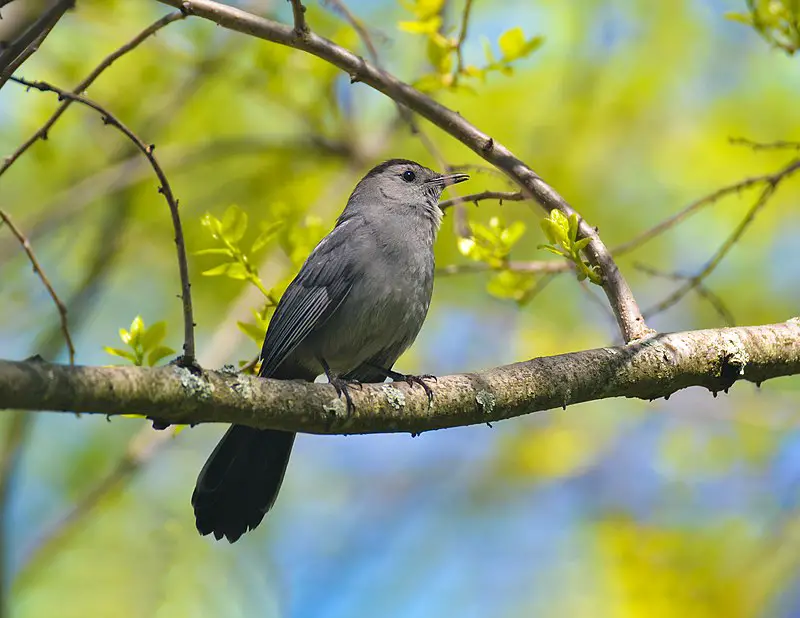
The Gray Catbird is a medium-sized bird native to North and Central America. It is the only species in its genus, Dumetella, which makes it unique among other perching birds of the Mimidae family.
Its plumage features shades of grey with some brownish tones on top and lighter grey below.
The underside of its tail has white feathers contrasting against their otherwise monochromatic colouration; this feature gives them their name as they often flick their tails when alarmed or excited as cats do.
They are omnivorous but mainly feed on insects such as caterpillars, grasshoppers, and beetles while eating fruits like berries or cherries during summer.
Despite being commonly seen alone or in pairs, these birds will sometimes flock together for protection from predators like hawks, who are drawn to their dark colouration against green foliage, making them harder to spot.
Scientific classification:
| Kingdom | Animalia |
| Phylum | Chordata |
| Class | Aves |
| Order | Passeriformes |
| Family | Mimidae |
| Genus | Dumetella C.T. Wood, 1837 |
| Species | D. carolinensis |
31. Ruby-Throated Hummingbird
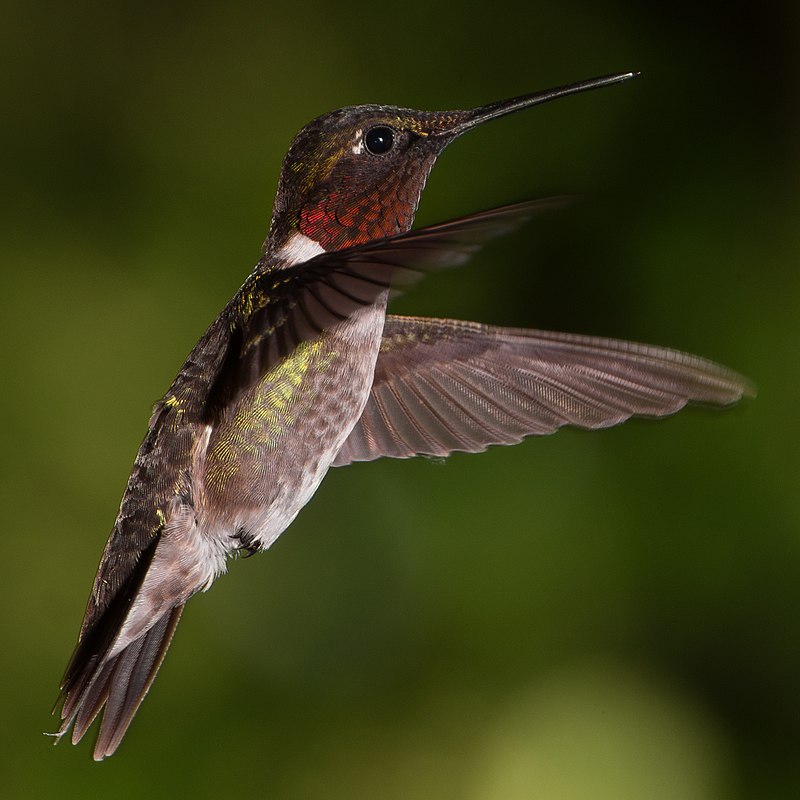
The ruby-throated hummingbird (Archilochus colubris) is a hummingbird species with an impressive migration pattern, spending the winter in Central America, Mexico and Florida before flying to Canada and other parts of Eastern North America for the breeding season.
It’s by far the most common type seen east of the Mississippi River in North America.
Formally described by Swedish naturalist Carl Linnaeus in 1758, this tiny bird has bright metallic green upperparts with white underparts, a small black bill and a red throat patch, which gives it its name; they measure around 3 inches long on average.
They feed primarily on nectar from flowers but also eat insects such as flies or mosquitoes for extra protein during their migrations or when raising young chicks.
Scientific classification:
| Kingdom | Animalia |
| Phylum | Chordata |
| Class | Aves |
| Order | Apodiformes |
| Family | Trochilidae |
| Genus | Archilochus |
| Species | A. colubris |
32. American Yellow Warbler
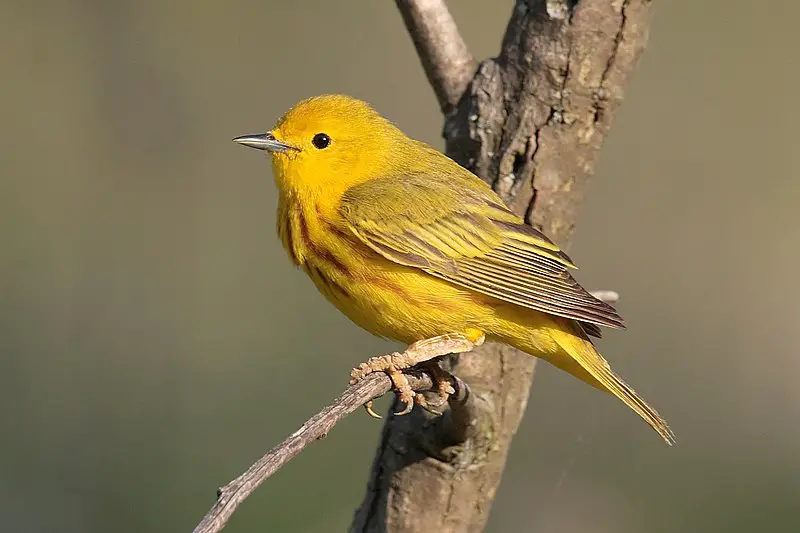
The American Yellow Warbler (Setophaga petechia) is a species of New World warbler found across North America, the Caribbean, and northern South America.
Its genus name, Setophaga, comes from Ancient Greek words meaning “moth” and “eating”, while its specific name, Petechia, originates from Italian for small red spots.
This bird has striking yellow plumage with reddish-brown streaks on their chest that can be seen during mating season when they are most colourful.
They live in open woodlands near wetlands or bodies of water where they can find food such as insects like spiders, beetles and caterpillars, which comprise much of their diet.
The male will sing to attract a mate during the breeding season before setting up a home in twig nests built by both sexes together high in trees or shrubs.
Scientific classification:
| Kingdom | Animalia |
| Phylum | Chordata |
| Class | Aves |
| Order | Passeriformes |
| Family | Parulidae |
| Genus | Setophaga |
| Species | S. petechia |
33. Red-Headed Woodpecker
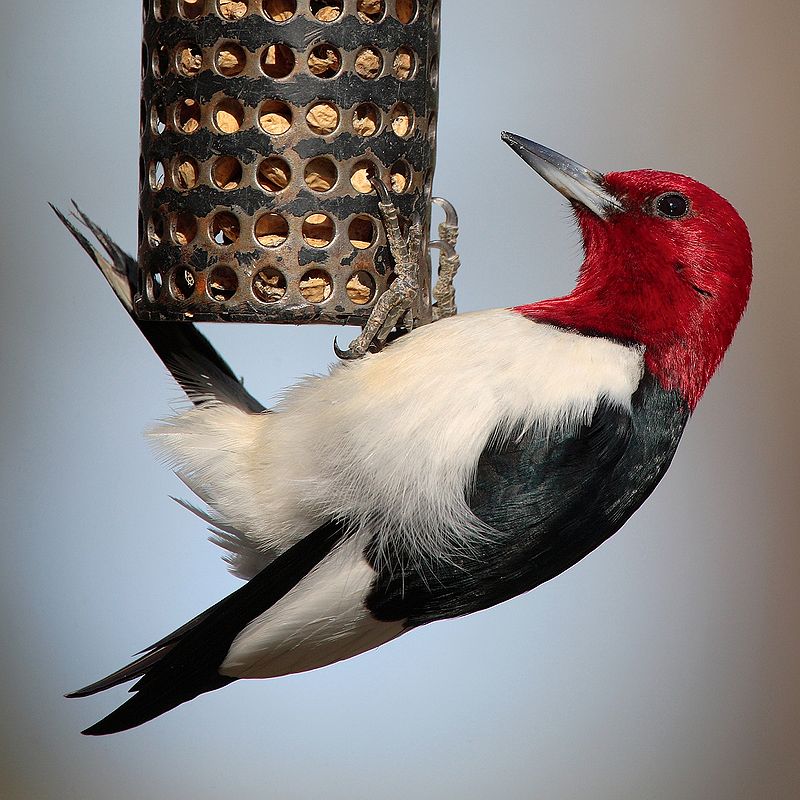
The red-headed woodpecker is a mid-sized bird found in temperate North America. It has striking plumage, with its head and neck being bright red, while the rest of its body is primarily black and white.
Its wings are rounder than other similar species, allowing it to maneuver through tight spaces easily when searching for food or shelter.
The breeding habitat of this bird consists mainly of open fields across Canada and the east-central United States.
Despite facing threats such as deforestation, urbanization, predation from larger birds, and collisions with windows or cars due to their inquisitive nature.
These birds remain listed on IUCN’s Red List as the least concerned, thanks largely to conservation efforts by local governments and organizations dedicated to protecting wildlife habitats.
Scientific classification:
| Kingdom | Animalia |
| Phylum | Chordata |
| Class | Aves |
| Order | Piciformes |
| Family | Picidae |
| Genus | Melanerpes |
| Species | M. erythrocephalus |
34. White-Throated Sparrow
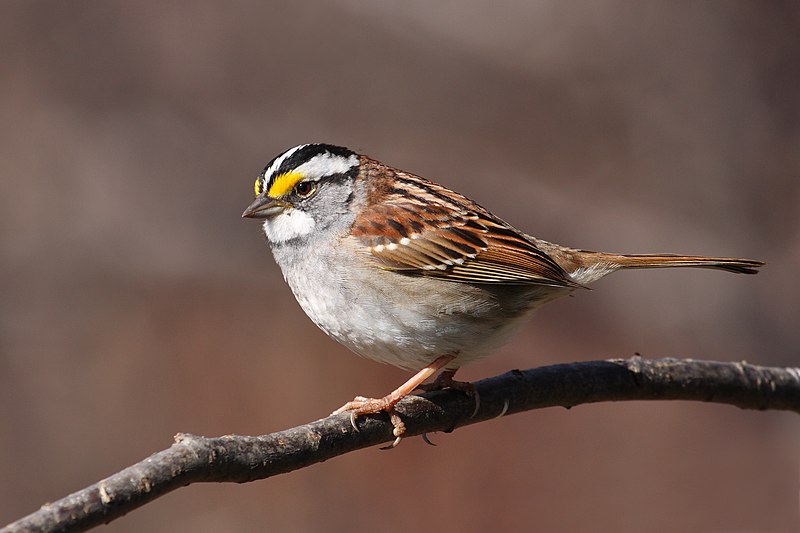
The White-throated Sparrow is a small passerine bird of the New World sparrow family, Passerellidae.
It has distinctive yellow and black stripes on its head, white throat and chest, grey back and wings, and light brown legs.
The scientific name “Zonotrichia albicollis” comes from Ancient Greek for ‘band’, referring to its distinctive striped crown, and Latin for ‘white neck’ (albus collum).
These birds are usually found in wooded areas such as coniferous forests or deciduous habitats in North America, where they feed mainly on insects during the summer months, transitioning to seeds during winter.
They build their nests near ground level using grasses, twigs or moss lined with feathers.
White-throated Sparrows may be solitary but also form flocks when migrating southward each fall season, which typically occurs over mid-late October through November, depending on location within range.
Scientific classification:
| Kingdom | Animalia |
| Phylum | Chordata |
| Class | Aves |
| Order | Passeriformes |
| Family | Passerellidae |
| Genus | Zonotrichia |
| Species | Z. albicollis |
35. Indigo Bunting
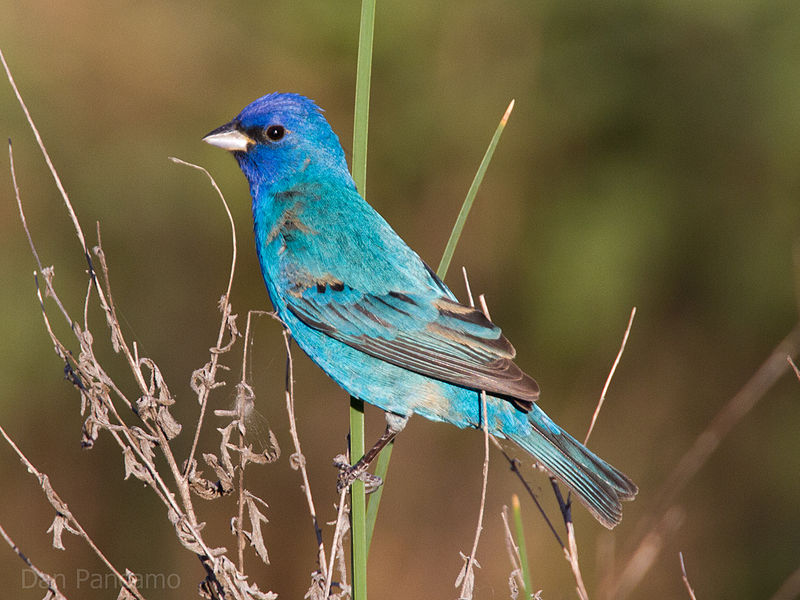
The Indigo Bunting is a small bird in the cardinal family throughout North and South America.
It has an unmistakable bright blue plumage that stands out against its natural habitat of farmland, brush areas and open woodland.
During the breeding season, it can be seen from southern Canada to northern Florida, while during winter months, it migrates south towards Central and Northern South America.
The Indigo Bunting prefers to migrate at night using the stars as navigation aids.
This species feeds on insects and seeds which they find near the ground or catch mid-flight with their agile wingspan.
An iconic sight for many farmers across both continents, these birds are a welcome addition to any backyard oasis or wildflower meadow.
Scientific classification:
| Kingdom | Animalia |
| Phylum | Chordata |
| Class | Aves |
| Order | Passeriformes |
| Family | Cardinalidae |
| Genus | Passerina |
| Species | P. cyanea |
36. Common Yellowthroat
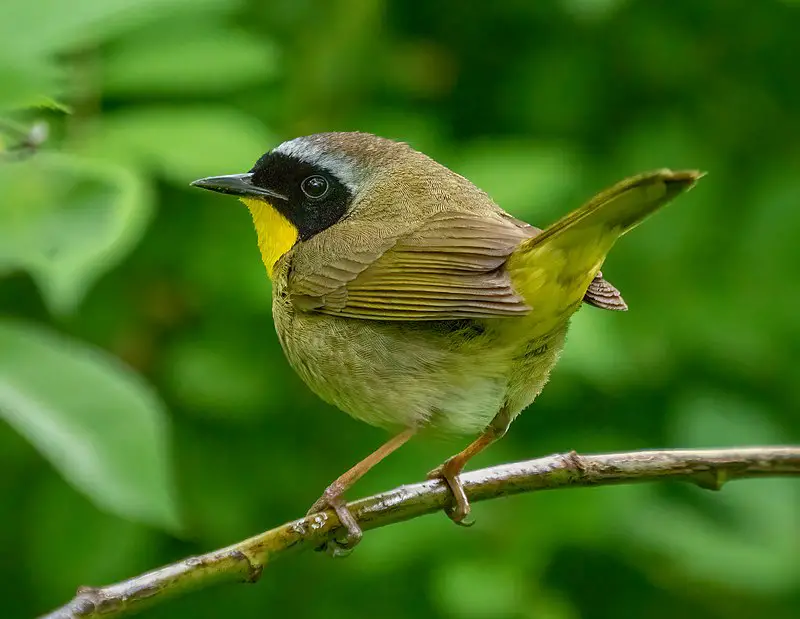
The Common Yellowthroat is a small New World Warbler found throughout North America. It has distinctive yellow and black plumage, earning it the nickname “Yellow Bandit” in the Midwest United States.
This species is highly adaptable and can be found inhabiting wetlands, grasslands, shrubland habitats, and suburban areas.
The genus of this bird’s scientific name means ‘ground’ and ‘small bird’, which are fitting characteristics for such an elusive yet common little creature.
Its diet consists predominantly of insects but may also include other invertebrates like spiders or worms.
Overall the Common Yellowthroat makes an excellent addition to any backyard with its cheerful song.
Scientific classification:
| Kingdom | Animalia |
| Phylum | Chordata |
| Class | Aves |
| Order | Passeriformes |
| Family | Parulidae |
| Genus | Geothlypis |
| Species | G. trichas |
37. Blue-Gray Gnatcatcher
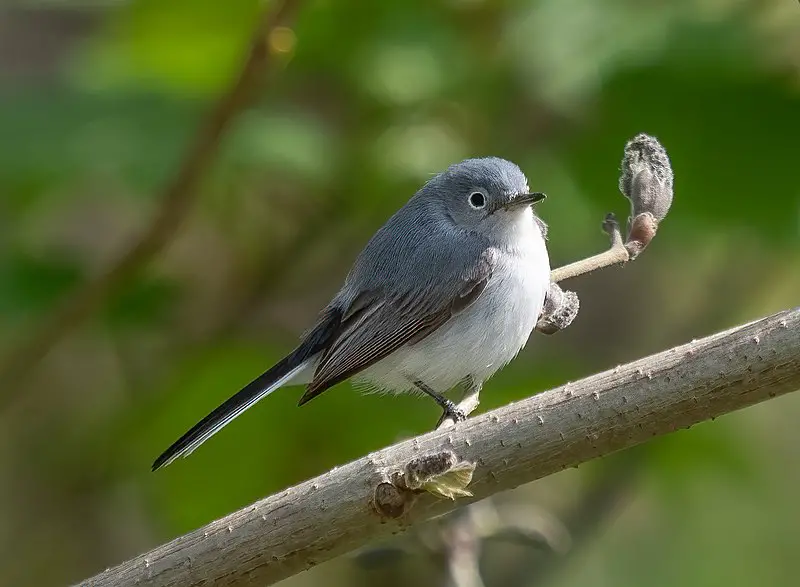
The Blue-gray Gnatcatcher is a beautiful small songbird native to North America. It has a length of 10–13 cm (3.9–5.1 in), a wingspan of 6.3 in (16 cm) and weighs only 5–7 g (0.18–0.25 oz).
Males have blue-grey upper parts with white underparts, slender dark bills, and long black tails edged in white; females are less vibrant but still eye-catching.
Juveniles are brownish grey overall but may show some hints of adult colouration around their tails or shoulders as they mature into adulthood.
Their diet consists mainly of insects, which they catch while flitting through the air like tiny darts.
This stunning species can be found anywhere from woodlands to urban parks, so keep your eyes peeled for these delightful creatures on your next outdoor adventure.
Scientific classification:
| Kingdom | Animalia |
| Phylum | Chordata |
| Class | Aves |
| Order | Passeriformes |
| Family | Polioptilidae |
| Genus | Polioptila |
| Species | P. caerulea |
38. Tundra Swan

The Tundra swan is a small species of swan found in the Holarctic region. It can be divided into two separate taxa, Bewick’s Swan and Whistling Swan.
The former inhabits the Palearctic area, while the latter resides near North America.
These birds are typically white with black bills and eyes, but their legs vary from yellow to greyish-black depending on which subspecies they belong to.
They feed mainly on aquatic plants such as algae, roots, tubers and various types of seeds.
During migration, these birds fly together in large flocks that may contain hundreds or even thousands of individuals at one time.
This majestic bird is an important part of many wetland ecosystems worldwide. It is vital in controlling vegetation growth and dispersing nutrients across its habitat range.
Scientific classification:
| Kingdom | Animalia |
| Phylum | Chordata |
| Class | Aves |
| Order | Anseriformes |
| Family | Anatidae |
| Genus | Cygnus |
| Species | C. columbianus |
39. House Wren
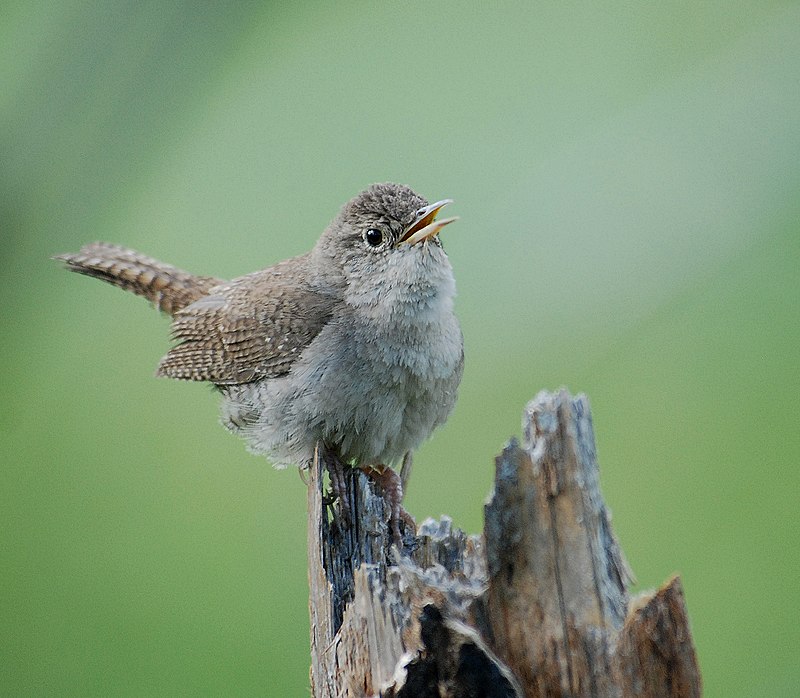
The House Wren is a small bird of the Wren family found in Canada and South America. It’s quite common in suburban areas and is one of the most widely distributed native birds in North and South America.
Its taxonomy can be complicated, with some subspecies groups considered separate species. The House Wren has a brown back, grey head, white eyebrow stripes, light chestnut belly and buffy flanks.
They often inhabit old or abandoned buildings and shrublands near fields or open woods for nesting sites.
During the breeding season, they are highly territorial, so make sure you create an inviting environment if you wish to invite them into your yard.
Scientific classification:
| Kingdom | Animalia |
| Phylum | Chordata |
| Class | Aves |
| Order | Passeriformes |
| Family | Troglodytidae |
| Genus | Troglodytes |
| Species | T. aedon |
40. Bald Eagle
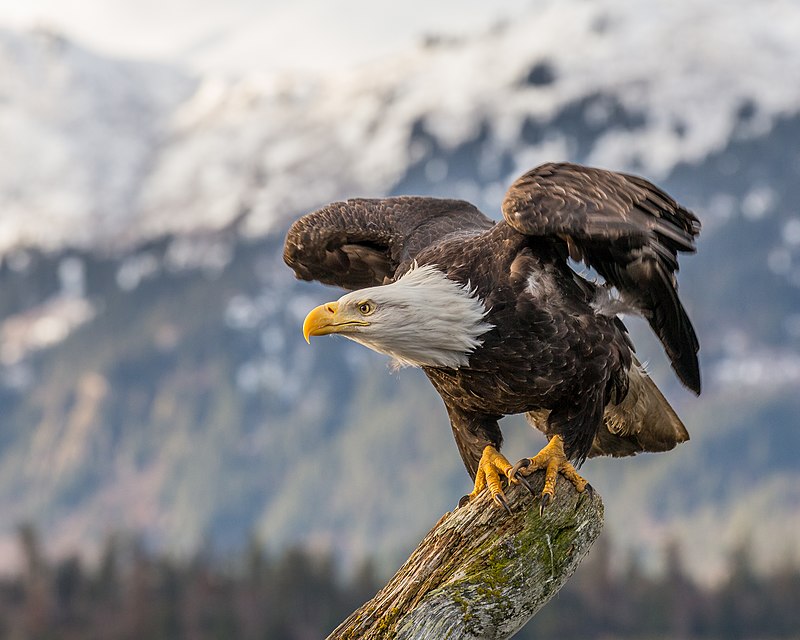
The majestic Bald Eagle is a bird of prey found in North America and recognized as the national symbol of the United States.
With its distinctive white head, brown body and striking yellow beak, this sea eagle has two known subspecies that form a species pair with the White-tailed Eagle.
It inhabits much of Canada, Alaska, all states in the US, contiguous areas, and Northern Mexico near large bodies of water where they feed mainly on fish.
These birds have an impressive wingspan ranging from 1.8 to 2 meters depending on their size, making them one of nature’s most magnificent creatures.
Scientific classification:
| Kingdom | Animalia |
| Phylum | Chordata |
| Class | Aves |
| Order | Accipitriformes |
| Family | Accipitridae |
| Genus | Haliaeetus |
| Species | H. leucocephalus |
41. Chipping Sparrow
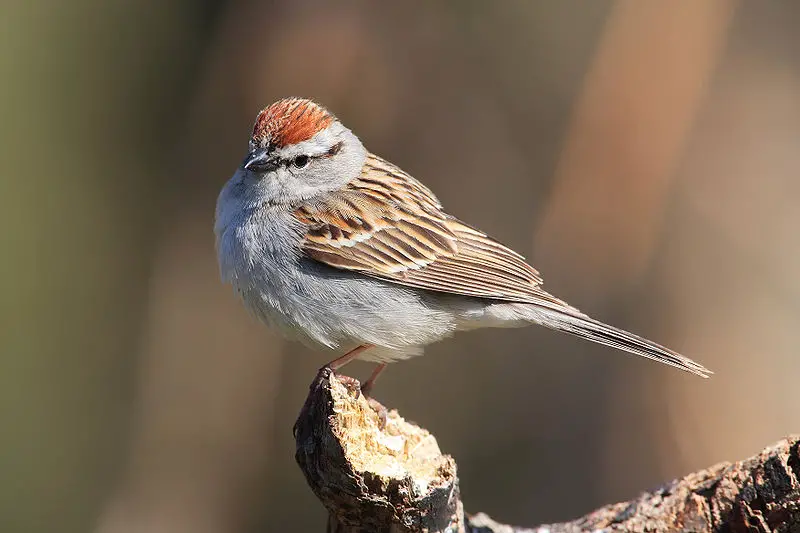
The Chipping Sparrow is a small passerine bird in most of North America. It has two subspecies, the eastern and western chipping sparrows, which migrate seasonally to overwinter in warmer climates.
The birds are grey above with white underparts, have a rufous cap with black stripes and large eyes surrounded by light brown feathers.
They feed mainly on seeds but can also be seen eating insects during breeding season when raising their young chicks.
These intrepid little birds live in open grasslands such as prairies or meadows, building cup-shaped nests in trees or shrubs to raise their young family.
Their cheerful song often sounds like ‘chips’, hence its name: Chipping Sparrow.
Scientific classification:
| Kingdom | Animalia |
| Phylum | Chordata |
| Class | Aves |
| Order | Passeriformes |
| Family | Passerellidae |
| Genus | Spizella |
| Species | S. passerina |
42. Ruddy Duck
The Ruddy Duck is a North American duck species native to Jamaica, known for its sharp tail.
It was formally described in 1789 by the German naturalist Johann Friedrich Gmelin and placed into Carl Linnaeus’ Systema Naturae.
These ducks are medium-sized, with males having greyish cheeks and foreheads while females have brown heads. Both sexes also feature an orange bill with a blue base and a white patch on their faces near their bills.
In winter, they can be found inhabiting freshwater ponds, lakes or marshes, where they feed mainly on aquatic vegetation like algae or small insects, molluscs or crustaceans, and plant material from nearby land.
They tend to flock together during migration season when going southwards for warmer climates but usually remain solitary throughout other times unless breeding occurs between April and June each year.
Nest-building activities involve gathering materials for lining nests close to water sources before laying eggs that will hatch after about one month.
| Kingdom | Animalia |
| Phylum | Chordata |
| Class | Aves |
| Order | Anseriformes |
| Family | Anatidae |
| Genus | Oxyura |
| Species | O. jamaicensis |
43. Northern Bobwhite
The Northern bobwhite is a ground-dwelling bird native to parts of the Americas, with introduced populations elsewhere in the world.
It belongs to the New World quail family and has a distinctive call that can be heard during mating season or when its territory is threatened.
They have mottled brown plumage, which helps them blend into their natural habitats, such as grasslands, wooded areas and open fields. The male birds are slightly larger than females and feed on small insects, seeds and plants.
These birds form monogamous breeding pairs that stay together throughout most of the year, raising several broods each year until migrating south for winter months.
Though declining due to habitat loss, these resilient little birds can still live in many places across North America.
Scientific classification:
| Kingdom | Animalia |
| Phylum | Chordata |
| Class | Aves |
| Order | Galliformes |
| Family | Odontophoridae |
| Genus | Colinus |
| Species | C. virginianus |
44. Eastern Towhee
The Eastern Towhee is a large New World sparrow native to brushy areas of eastern North America. These birds have distinct black and white markings, with chestnut brown underparts.
They nest either low in bushes or on the ground beneath shrubs. Northern towhees are known for migrating south during the winter months.
In recent decades, taxonomy debates have left some questioning whether this bird should remain its own species or be grouped together with the Spotted Towhee as one species — Rufous-sided Towhee.
This lively songbird has a bubbly personality and can often hop around on branches looking for food such as insects, fruits and seeds.
Scientific classification:
| Kingdom | Animalia |
| Phylum | Chordata |
| Class | Aves |
| Order | Passeriformes |
| Family | Passerellidae |
| Genus | Pipilo |
| Species | P. erythrophthalmus |
45. Eastern Meadowlark
The Eastern meadowlark is a medium-sized blackbird found from eastern North America to northern South America.
It used to be considered the same species as the Western meadowlark but has since
been separated into its own distinct species.
The bird is mainly brown with yellow underparts and an orange patch on its throat; it also has white wing bars, which can be seen in flight.
Its song consists of a series of musical whistles followed by gurgling notes at the end, earning them their nickname “rainmaker” birds because they are believed to bring rain if heard singing during dry weather.
These beautiful birds feed mostly on insects, seeds and other plant material while nesting amongst grasses or low shrubs near open fields where there’s plenty of food available for them.
Scientific classification:
| Kingdom | Animalia |
| Phylum | Chordata |
| Class | Aves |
| Order | Passeriformes |
| Family | Icteridae |
| Genus | Sturnella |
| Species | S. magna |
46. Swifts
Swifts are small, aerial birds that belong to the Apodidae family. They look similar to swallows but they aren’t related in any way.
Swifts have evolved differently from other passerines and instead share an order with hummingbirds – the Apodiformes.
The Hemiprocnidae also shares a close relationship with swifts, being referred to as ‘treeswift’ due to their affinity for perching on trees rather than flying through the air like regular swifts do.
While these two species may appear quite similar at first glance, closer inspection will reveal vast differences between them which has come about over time via convergent evolution.Scientific classification:
| Kingdom | Animalia |
| Phylum | Chordata |
| Class | Aves |
| Order | Apodiformes |
| Family | Apodidae Hartert, 1897 |
47. Scarlet Tanager
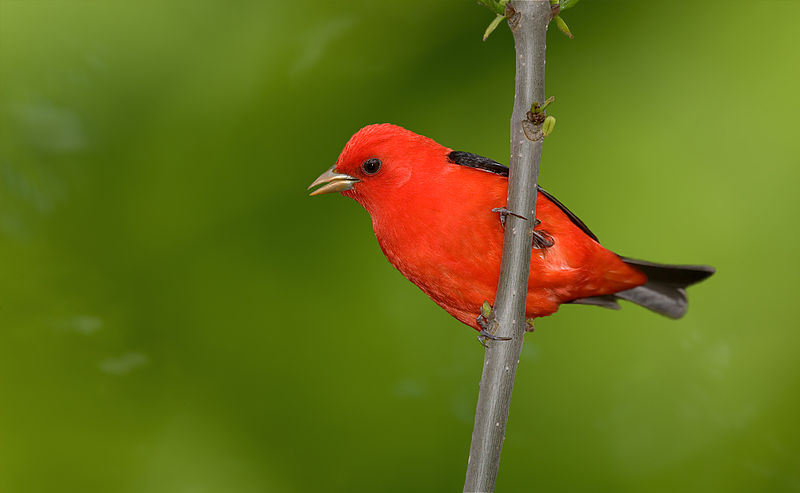
The Scarlet Tanager is a beautiful medium-sized bird in North and South America. It belongs to the Cardinal family and has striking red plumage with black wings and tail feathers.
Its song is similar to other cardinals yet also unique in its own way – it’s recognizable by its high whistles that become lower towards the end.
The species feeds mainly on insects and berries from trees or shrubs during the breeding season, when they may form loose flocks over open woodlands foraging for food.
They are highly territorial birds during nesting season, which happens between April and June; males and females fiercely defend their nests against intruders such as cats or squirrels.
Scientific classification:
| Kingdom | Animalia |
| Phylum | Chordata |
| Class | Aves |
| Order | Passeriformes |
| Family | Cardinalidae |
| Genus | Piranga |
| Species | P. olivacea |
48. Loons
Loons are aquatic birds found in both North America and northern Eurasia. They can be identified by their size, which is similar to that of large ducks or small geese.
When swimming, loons resemble these birds in shape as well as movement.
Unlike other waterfowl however, they have pointed bills with serrated edges and feet set far back on their bodies; this makes them excellent swimmers but hinders the ability to walk on land properly.
Loons feed mainly on fish but also eat insects and crustaceans when available.
In addition to being a common sight around lakes during warmer months, many species migrate south for winter where they live near coastal waters until returning again in springtime.Scientific classification:
| Kingdom | Animalia |
| Phylum | Chordata |
| Class | Aves |
| Order | Gaviiformes |
| Family | Gaviidae Coues, 1903[1] |
| Genus | Gavia Forster, 1788 |
49. Sandhill Crane
Sandhill Cranes are a large crane species native to North America and northeastern Siberia. They are known for their distinctive calls, long legs, and long necks.
These birds typically inhabit wetland areas like the Platte River in Nebraska’s Sandhills on the Great Plains.
In Central Florida, they often gather at the edges of bodies of water such as lakes or rivers.
During the breeding season, sandhill cranes can be seen performing elaborate courtship dances that involve bowing and jumping in unison with their partner.
Their diet consists mainly of plant material, including grains, roots, tubers and aquatic plants, which they obtain by pecking or digging into mudflats using their bill or feet.
With an average lifespan of 10-20 years, these majestic creatures greatly add to any wetland habitat.
Scientific classification:
| Kingdom | Animalia |
| Phylum | Chordata |
| Class | Aves |
| Order | Gruiformes |
| Family | Gruidae |
| Genus | Antigone |
| Species | A. canadensis |
To Recap
In the diverse avian tapestry of Ohio, we have explored 49 distinctive bird species, each contributing to the state’s rich natural heritage.
From the vibrant plumage of the Northern Cardinal to the melodious songs of the American Robin, Ohio offers a haven for both casual birdwatchers and avid ornithologists.
These feathered inhabitants are captivating to observe and crucial indicators of the state’s environmental health.
Ohio’s varied ecosystems, including wetlands, forests, and urban areas, provide homes for these birds, demonstrating the importance of preserving and conserving these diverse habitats.
As we continue to appreciate and protect these avian treasures, we enrich our understanding of nature and play a vital role in sustaining the ecological balance for generations to come.